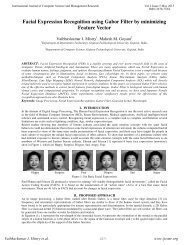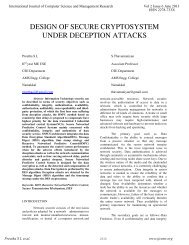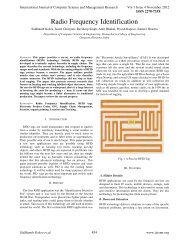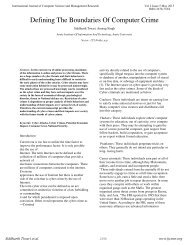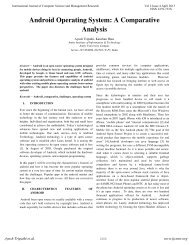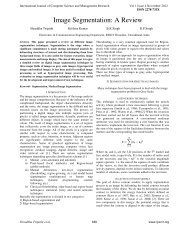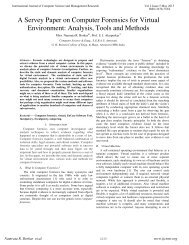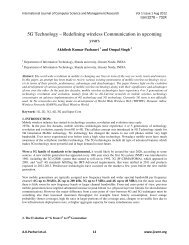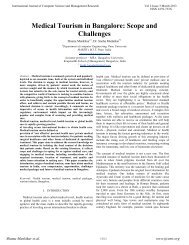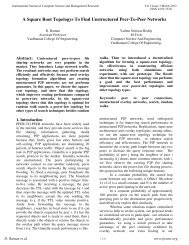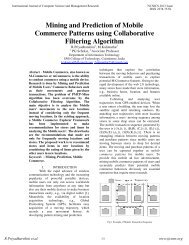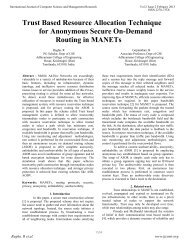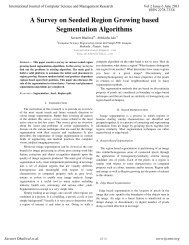segmentation techniques for image analysis: a review - ijcsmr
segmentation techniques for image analysis: a review - ijcsmr
segmentation techniques for image analysis: a review - ijcsmr
Create successful ePaper yourself
Turn your PDF publications into a flip-book with our unique Google optimized e-Paper software.
International Journal of Computer Science and Management Research Vol 2 Issue 1 January 2013<br />
ISSN 2278-733X<br />
2. Neural Network-based <strong>segmentation</strong><br />
REFERENCES<br />
Neural network based <strong>segmentation</strong> is totally different from<br />
conventional <strong>segmentation</strong> algorithms. In this algorithm, an<br />
<strong>image</strong> is firstly mapped into a neural network where every<br />
neuron stands <strong>for</strong> a pixel. Then, we extract <strong>image</strong> edges by<br />
using dynamic equations to direct the state of every neuron<br />
towards minimum energy defined by neural network.[8]<br />
Neural network based <strong>segmentation</strong> has three basic<br />
characteristics : 1) highly parallel ability and fast computing<br />
capability, which make it suitable <strong>for</strong> real-time application; 2)<br />
unrestricted nonlinear degree and high interaction among<br />
processing units, which make this algorithm able to establish<br />
modeling <strong>for</strong> any process;3) satisfactory robustness making it<br />
insensitive to noise. However, there are some drawbacks of<br />
neural network based <strong>segmentation</strong> either, such as: 1) some<br />
kinds of <strong>segmentation</strong> in<strong>for</strong>mation should be known<br />
be<strong>for</strong>ehand; 2) initialization may influence the result of <strong>image</strong><br />
<strong>segmentation</strong>; 3) neural network should be trained using<br />
learning process be<strong>for</strong>ehand, the period of training may be<br />
very long, and we should avoid overtraining at the same<br />
time[8].<br />
D. Model-Based Segmentation<br />
Major advantages in medical imaging provided physician with<br />
powerful non invasive technique to probe the structure,<br />
function, and pathology of human body.[13] All <strong>segmentation</strong><br />
<strong>techniques</strong> discussed so far utilize only local in<strong>for</strong>mation. The<br />
human vision system has the ability to recognize objects even<br />
if they are not completely represented. It is obvious that the<br />
in<strong>for</strong>mation that can be gathered from local neighborhood<br />
operators is not sufficient to per<strong>for</strong>m this task. Instead specific<br />
knowledge about the geometrical shape of the objects is<br />
required, which can then be compared with the local<br />
in<strong>for</strong>mation. This train of thought leads to model-based<br />
<strong>segmentation</strong>. It can be applied if we know the exact shape of<br />
the objects contained in the <strong>image</strong>.[5]<br />
IV. CONCLUSIONS<br />
In this paper, we classify and discuss main <strong>image</strong><br />
<strong>segmentation</strong> algorithms; introduce the evaluation of <strong>image</strong><br />
<strong>segmentation</strong> systemically; evaluate and compare basic,<br />
practical <strong>segmentation</strong> algorithms after a large number of<br />
comparative experiments[3][12]. Based on this, we now<br />
discuss the prospect of <strong>image</strong> <strong>segmentation</strong>. As the basic<br />
technique of <strong>image</strong> processing and computer vision, <strong>image</strong><br />
<strong>segmentation</strong> has a promising future and the universal<br />
<strong>segmentation</strong> algorithm has become the focus of<br />
contemporary research [8].<br />
[1] Krishna Kant Singh , Akansha Singh IJCSI International<br />
Journal of Computer Science Issues, Vol. 7, Issue<br />
5,September 2010.<br />
[2] Edge Detection Techniques Evaluations and<br />
Comparisons. Ehsan Applied Mathematical Sciences,<br />
Vol. 2, 2008, no. 31, 1507 - 1520.<br />
[3] Image Segmentation Techniques Rajeshwar Dass,<br />
priyanka, Swapna Devi IJECT Vol. 3, Issue 1, Jan. -<br />
March 2012<br />
[4] Implementation and Comparison of Different<br />
Segmentation Algorithms used <strong>for</strong> Underwater Images<br />
Based on Nonlinear Objective Assessments (ICACTE)<br />
2010<br />
[5] Efficient Implementation of Local Adaptive<br />
Thresholding Techniques Using Integral Images Faisal<br />
Shafait, Daniel Keysers, Thomas M. Breuel<br />
[6] Evaluating The Effectiveness Of Region Growing And<br />
Edge Detection Segmentation Algorithms.Ahmed R.<br />
Khalifa 2010<br />
[7] An Automatic Seeded Region Growing <strong>for</strong> 2D<br />
Biomedical Image Segmentation, M. M. Abdelsamea<br />
IPCBEE vol.21 (2011)<br />
[8] The Comparative Research on Image Segmentation<br />
Algorithms Wen-Xiong Kang, Qing-Qiang Yang, Run-<br />
Peng Liang IEEE- 2009<br />
[9] Synergy between Object Recognition and Image<br />
Segmentation Y.Ramadevi, B.Kalyani, T.Sridevi<br />
(IJCSE) 2010<br />
[10] A Survey on Image Segmentation Through Clustering<br />
International Journal of Research and Reviews in<br />
In<strong>for</strong>mation Sciences Vol. 1, No. 1, March 2011<br />
[11] Automatic Image Segmentation by Dynamic Region<br />
Merging Bo Peng, Lei Zhang, Member, IEEE, and David<br />
Zhang, Fellow, Ieee December 2011<br />
[12] Segmentation Techniques For Image Analysis<br />
IJAERS/Vol. I/ Issue II/January-March, 2012<br />
[13] Medical <strong>image</strong> SEGMENTATION Algorithm using<br />
de<strong>for</strong>mable model: <strong>review</strong> 2012, d. Jayadevappa, S.<br />
Kumar, D. S Murty<br />
[14] Pal, N. R. And Pal, S. K., 1993. A <strong>review</strong> on <strong>image</strong><br />
Segmentation <strong>techniques</strong>. Pattern Recognition, 26(9),<br />
Pp. 1274- 1294.<br />
[15] Zhang, Y. J., 1997. Evaluation and comparison of<br />
Different <strong>segmentation</strong> algorithms. Pattern Recognition<br />
Letters, 18(10). Pp. 963-974.<br />
Jay Acharya et.al. 1221 www.<strong>ijcsmr</strong>.org




